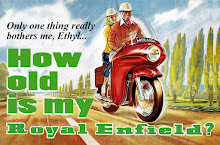 Lots of people ride Royal Enfield motorcycles into the tall mountains of India. Many are moved to write about the experience.
Lots of people ride Royal Enfield motorcycles into the tall mountains of India. Many are moved to write about the experience.Their accounts on the Internet are exciting and, often, philosophical. The altitude seems to inspire thoughts of Heaven, while the roads invariably provide a brush with the afterlife. The adventurers post beautiful pictures that leave me gasping for breath even here in my home, at sea level.
At least two reactions are possible:
1. These guys are nuts, and
2. I'm jealous.
Not jealous enough to do it myself, mind you. Too far, I tell myself. Too expensive, I assume. The truth is I don't want to do it bad enough to be that uncomfortable. But, if you want to tell me about it, with beautiful pictures, I will read.
And then came Ajit Harisinghani's book, One Life to Ride. He graciously offered to send me a copy to review. I accepted, although I was skeptical that there would be anything substantial I could add to the lavish praise it has received. The book itself includes several pages of glowing excerpts from reviews.
But, I was surprised. Here is the story of one man's journey by Royal Enfield to the High Himalayas, but it is not just a ride out story and it is not a picture gallery. It is (why does this seem so exceptional these days?) a book.
Instead of scanning a computer screen on the edge of my stiff office chair, I was able to join my wife in the library, where an armchair awaited. I felt no pressure to mentally download the story and rush off to another web site. Well, this is cozy, I thought.
My feet may have been propped on an ottoman, but my mind was still geared for Google. I encountered this passage:
"With a pooja-thali in his hands and shlokas on his lips, he leads and I follow him all the way into the temple where resides the deity in full splendour. Ensconced on the left in a large niche sits the Elephant God Ganesha, adorned with ornaments and surrounded by his favorite modak ladoos which are heaped on plates and may become the prasad after the pooja."
What the hell? I am sitting here in an armchair, I can't Google all these Hindi words, if that's what they are. This book, I decided, needs a Glossary.
I sped through the book in several sittings, enjoying some passages, but always waiting for "the good part" to start. It never seemed to come. And, then, on Page 225, I found the Glossary that was there all the time.
That should have told me right then that I had approached the book with the wrong attitude. But it was not until several weeks later that I found myself drawn to it again.
I had been thinking about how every time Harisinghani reaches a high point in his story he seems to pause and think. In part this practice is responsible for him having to travel alone instead of with the group he'd intended to join.
Kind of neat, I thought; he is traveling at Royal Enfield speed. The author is accumulating something besides miles and altitude. Enlightenment? Well, yes, I think so. And I could use some of that.
I read more slowly, the second time, and made use of the excellent glossary. I'm glad I did.
One last note. With full respect for all those who conquer the high mountains on Royal Enfields, I would like to point out that Ajit Harisinghani's trip was somewhat exceptional in two important regards:
1. He did it alone: no companions, no travel agents (in fact, no reservations), and no support team of mechanics following in a truck full of spare parts.
2. He rode his own motorcycle, not a rental. That alone makes me want to go out to the garage and give my Royal Enfield a hug.
For more information on buying One Life to Ride, click here.

























No comments:
Post a Comment